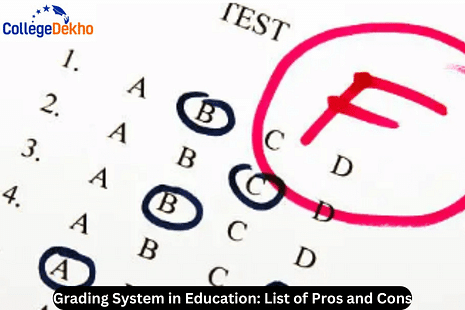
Grading system in education , which assesses a student’s educational performance based entirely on points, has been around for centuries. In fact, the A-F scale was first introduced by American educator Francis Walker in the late 19th century, and it’s still widely used today. The grading system provides a straightforward way to measure academic performance and track progress over time. But are grades really the best way to evaluate a student’s abilities?
While grades can motivate students to push themselves, they can also discourage those who struggle. From our early years, parents and teachers have emphasized the importance of grades as a reflection of intelligence. But is that always the case? Keep reading to know more about the advantages and disadvantages of the grading system in education!
Related Read:
| HBSE Class 12 Grading System | HBSE Haryana Board Class 10 Grading System |
|---|---|
| IGNOU Grading System | DU Grading System |
Traditional Grading System in India
Have you ever thought why the A-F grading system remains so widely used in India’s education system? The traditional grading scale has been around for decades, and while it’s simple and familiar, it comes with its own set of pros and cons.
The A-F scale is the most common, with "A" representing the highest achievement and "F" indicating failure. Some schools also use the number-based systems like 1-100 or 0-100, while others combine numbers and letters. It's a straightforward way to measure student performance and is easily understood by both teachers and students alike.
However, the rigidity of the traditional grading system in India can sometimes penalize students who understand the content but may take longer to grasp it. For example, a low score early in the school year can be tough to recover from, even if the student masters the concept later on. The system can also be subjective, with grading standards varying from teacher to teacher, leaving room for inconsistencies.
Still, the A-F scale remains a standard for a reason. It’s well-established, making comparisons between students easier and grading more transparent. Given below is the typical grading system used in India:
- A = 90-100%
- B = 80-89%
- C = 70-79%
- D = 60-69%
- F = 0-59%
Some schools in India even add pluses and minuses to better define where a student falls within the letter grade range, like a 96% being an A+ and a 93% being an A-.
Purpose of Grading System in Education in India
The concept of grading students is a topic that has sparked debate among educators for years! Some argue that grades are important to measure how well a student has grasped the subject, while others feel that grades can sometimes negatively affect a student’s confidence and motivation. So, what’s the real purpose behind the grading system?
At its core, grading serves as a tool to help teachers assess a student’s performance in each subject. It gives a clear picture of how well the student understands the concept, making it easier for teachers to spot areas where improvement is needed. In a way, the grading system not only tracks progress but also guides teachers to provide the right support where students need it the most. It’s all about fostering growth and helping students reach their full potential.
Types of Grading System in Education
The grading system in education in India has evolved significantly, especially since the introduction of the grading framework by CBSE (Central Board of Secondary Education) in 2009. The various types of grading system in education are as follows:
- CGPA: Cumulative Grade Point Average, popularly known as CGPA , is the most popular grading system in colleges and schools. This method calculates a student's average performance across all subjects and usually expressed on a scale from 0 to 10.
- Percentage: Student’s scores are presented as a percentage out of 100.
- Letter Grading: This system assigns letter grades (A, B, C, etc.) based on ranges of percentage scores.
Check Out:
| CBSE Class 12 Grading System | CBSE Class 10 Grading System |
|---|---|
| SGPA Grading System | ICSE 10th Grading System |
Advantages of Grading System in Education
What are the advantages of grading system in India? Discussed below are some key advantages and how it helps shape student’s futures without overwhelming them.
Reduces Pressure on Students
One of the biggest benefits of the grading system in education is that it reduces the stress on students. In many cases, their actual scores are not heavily scrutinized in their final GPA, which means that scoring lower in a subject would not affect their academic future. This helps students focus on learning rather than just chasing top grades, giving them the freedom to explore without fear of failure.
Clear Identification of Strengths and Weaknesses
Grades make it easier for students to see where they excel and where they need to improve. If a student scores a C or D in a subject, it’s a clear indication that they need to improve and focus more on that area. This simple feedback system guides students in setting priorities and allocating their efforts effectively.
Simplifies Classwork
Here’s something interesting: knowing they only need a passing grade like a D to scrape through can sometimes be a relief for students. While higher grades are always an option, this gives them the flexibility to decide how much effort they want to invest, without unnecessary stress.
Easy to Understand and Use
The grading system for students is straightforward. Each percentage correlates with a specific letter grade, making it easy for students, teachers, parents, and even admission committees to understand performance levels at a glance.
Helps and Comparison and Decision Making
Grades also serve as a valuable tool for comparison. Teachers can see how each student is performing in relation to their peers, which helps in identifying who might need extra support. Additionally, the grading system is used for college admissions, scholarships, and even job opportunities. They often play a deciding role in determining eligibility for higher education and professional opportunities.
Cons of Grading System in Education
When it comes to the grading system in education, it’s important to consider the drawbacks it can present. While it seems like a straightforward way to measure student performance, does it truly reflect their knowledge and growth?
No Real Drive for Competition
Does getting a simple passing grade truly motivate students to push their limits? Unfortunately, when all you need is to pass, the motivation to excel often fades. With grades like a D or an F, students might feel like they’re “good enough” and stop striving for improvement. An A grade might reflect a student’s caliber, but for others, just passing can lead to laziness, which doesn’t encourage healthy competition or growth.
Doesn’t Reflect True Knowledge
A single letter cannot capture the full extent of what a student has learned. Just because someone passes an exam doesn’t mean they’ve mastered the subject. The grading system often fails to show the depth of knowledge gained. Students may be focused on earning a particular grade rather than truly understanding the concept.
Inaccurate Measurement of Effort
Grades don’t always reflect the effort students put in. For example, if social studies isn’t your strongest subject but you manage to get a C after intense studying, does that C truly show the struggle and hard work you’ve put in? On the other hand, some students may get high grades by cramming or without fully understanding the material, which highlights the biggest flaw of the system.
Limited Incentives for Real Learning
The current grading system in education usually pushes students towards rote memorization rather than genuine exploration. The focus shifts to achieving a high grade rather than understanding concepts deeply. While a B or a C might motivate students to aim for an A, it can also lead to learning just for the sake of exams rather than long-term knowledge.
While grades are an easy way to measure performance, they don’t always tell the full story. Students and teachers alike might be better served by a system that prioritizes understanding and growth over mere letter grades. What do you think? Could there be a better way to measure student progress?
















Similar Articles
SAMS Odisha +2 Admissions 2025: Application Form, Selection Process, Merit List, Top Colleges
How to Score 90 Percent in Class 12? - Preparation Tips to Score 90% in 12th
How to Score 90 Percent in Class 10? - Subject-Wise Preparation Tips to Score 90%
Police Ranks in India: Check Rank List PDF, Police Posts with Badges, Stars & Salary
Top 10 North Campus Colleges in Delhi University (DU): NIRF Ranking & Popular Courses
REET 2025: Notification, Application Form, Exam Date and More